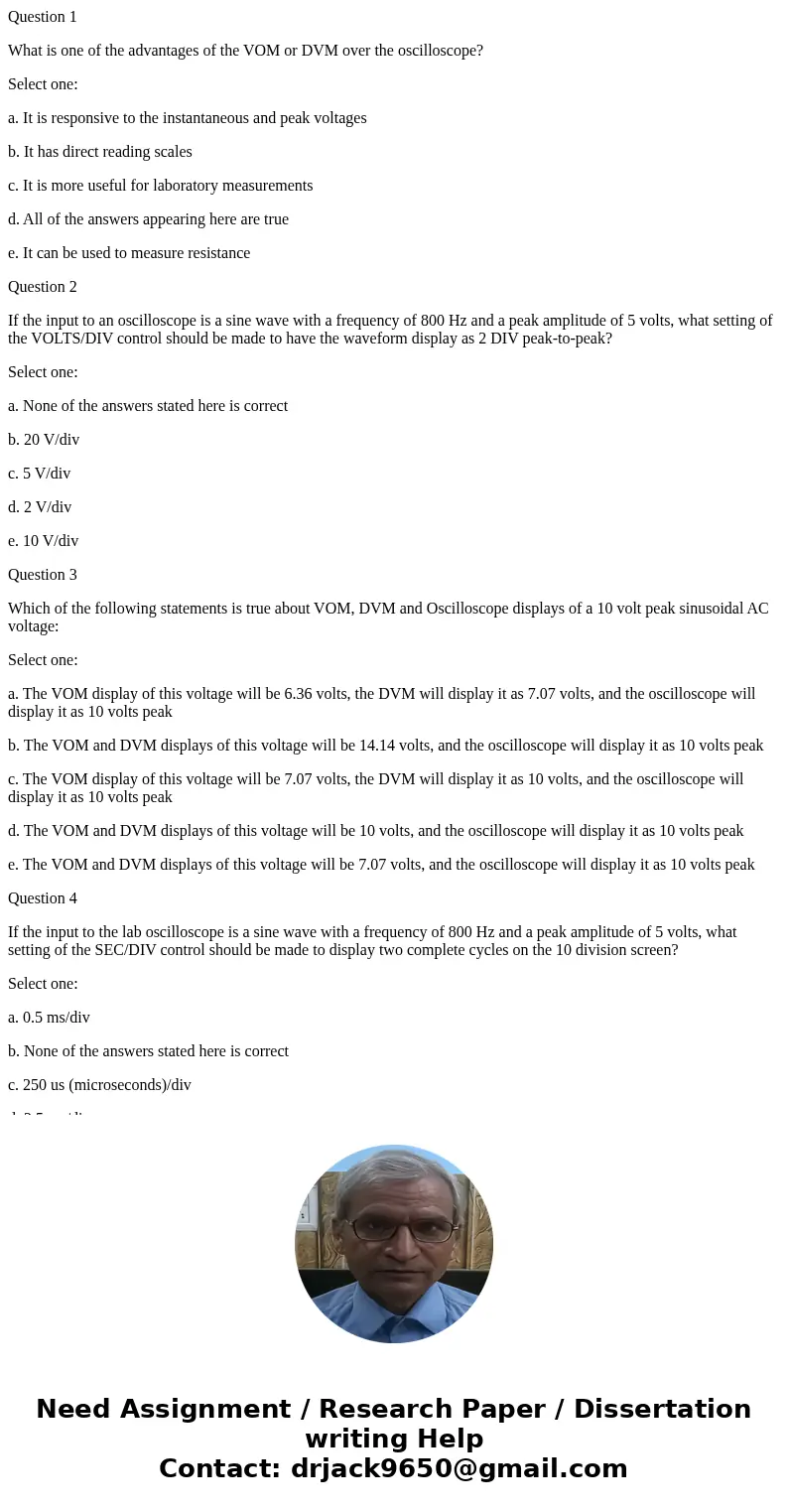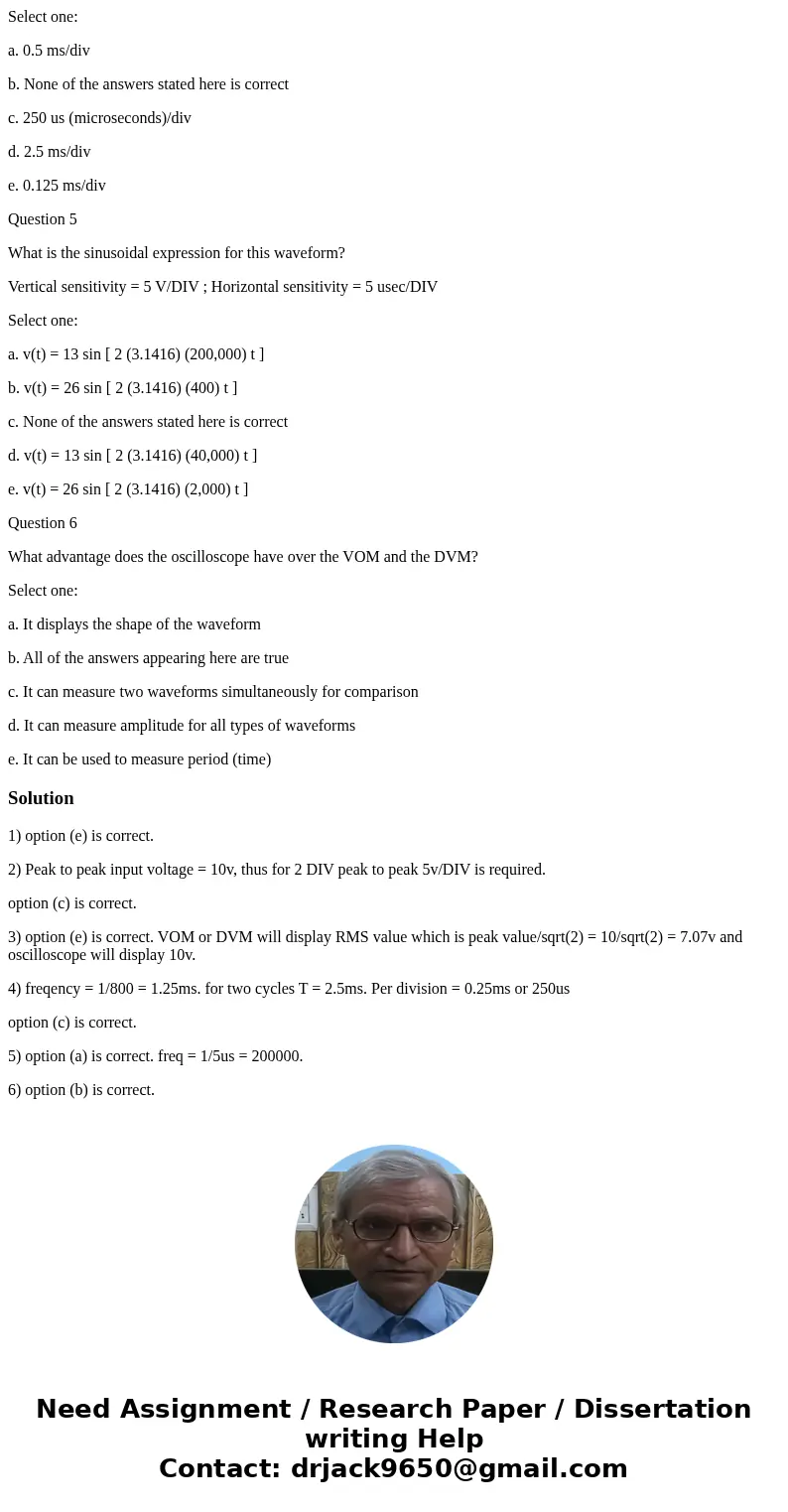Question 1 What is one of the advantages of the VOM or DVM o
Question 1
What is one of the advantages of the VOM or DVM over the oscilloscope?
Select one:
a. It is responsive to the instantaneous and peak voltages
b. It has direct reading scales
c. It is more useful for laboratory measurements
d. All of the answers appearing here are true
e. It can be used to measure resistance
Question 2
If the input to an oscilloscope is a sine wave with a frequency of 800 Hz and a peak amplitude of 5 volts, what setting of the VOLTS/DIV control should be made to have the waveform display as 2 DIV peak-to-peak?
Select one:
a. None of the answers stated here is correct
b. 20 V/div
c. 5 V/div
d. 2 V/div
e. 10 V/div
Question 3
Which of the following statements is true about VOM, DVM and Oscilloscope displays of a 10 volt peak sinusoidal AC voltage:
Select one:
a. The VOM display of this voltage will be 6.36 volts, the DVM will display it as 7.07 volts, and the oscilloscope will display it as 10 volts peak
b. The VOM and DVM displays of this voltage will be 14.14 volts, and the oscilloscope will display it as 10 volts peak
c. The VOM display of this voltage will be 7.07 volts, the DVM will display it as 10 volts, and the oscilloscope will display it as 10 volts peak
d. The VOM and DVM displays of this voltage will be 10 volts, and the oscilloscope will display it as 10 volts peak
e. The VOM and DVM displays of this voltage will be 7.07 volts, and the oscilloscope will display it as 10 volts peak
Question 4
If the input to the lab oscilloscope is a sine wave with a frequency of 800 Hz and a peak amplitude of 5 volts, what setting of the SEC/DIV control should be made to display two complete cycles on the 10 division screen?
Select one:
a. 0.5 ms/div
b. None of the answers stated here is correct
c. 250 us (microseconds)/div
d. 2.5 ms/div
e. 0.125 ms/div
Question 5
What is the sinusoidal expression for this waveform?
Vertical sensitivity = 5 V/DIV ; Horizontal sensitivity = 5 usec/DIV
Select one:
a. v(t) = 13 sin [ 2 (3.1416) (200,000) t ]
b. v(t) = 26 sin [ 2 (3.1416) (400) t ]
c. None of the answers stated here is correct
d. v(t) = 13 sin [ 2 (3.1416) (40,000) t ]
e. v(t) = 26 sin [ 2 (3.1416) (2,000) t ]
Question 6
What advantage does the oscilloscope have over the VOM and the DVM?
Select one:
a. It displays the shape of the waveform
b. All of the answers appearing here are true
c. It can measure two waveforms simultaneously for comparison
d. It can measure amplitude for all types of waveforms
e. It can be used to measure period (time)
Solution
1) option (e) is correct.
2) Peak to peak input voltage = 10v, thus for 2 DIV peak to peak 5v/DIV is required.
option (c) is correct.
3) option (e) is correct. VOM or DVM will display RMS value which is peak value/sqrt(2) = 10/sqrt(2) = 7.07v and oscilloscope will display 10v.
4) freqency = 1/800 = 1.25ms. for two cycles T = 2.5ms. Per division = 0.25ms or 250us
option (c) is correct.
5) option (a) is correct. freq = 1/5us = 200000.
6) option (b) is correct.


 Homework Sourse
Homework Sourse